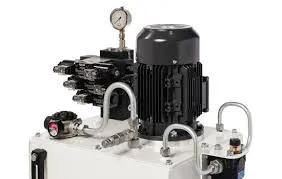Nov . 27, 2024 07:12 Back to list
Hydraulic Cylinder Pump Manufacturer for Efficient Fluid Power Solutions
The Importance of Choosing the Right Pump for Hydraulic Cylinders
Hydraulic systems have become integral to various industries, from manufacturing and construction to agriculture and transportation. At the core of these systems is the hydraulic cylinder, a device that converts hydraulic energy into mechanical energy, providing the force needed to perform various tasks. The efficiency and reliability of hydraulic cylinders heavily depend on the pump used to supply hydraulic fluid. As such, selecting the right pump for hydraulic cylinders is crucial for optimal system performance.
Understanding Hydraulic Pumps
Hydraulic pumps are mechanical devices designed to move hydraulic fluid through the system, creating pressure that enables the hydraulic cylinders to operate. The efficiency of a hydraulic system lies in the synergy between the pump and the cylinder. Different types of pumps, such as gear pumps, piston pumps, and vane pumps, each have unique characteristics that can influence the performance of your hydraulic cylinder.
1. Gear Pumps Known for their simplicity and reliability, gear pumps are often used in applications requiring consistent flow and pressure. They operate by using rotating gears to create suction that draws hydraulic fluid into the pump and then pushes it into the system. While they are generally less efficient at high pressures, they are ideal for low to medium-pressure applications.
2. Piston Pumps For applications demanding high pressure and precision, piston pumps are a preferred choice. They operate by using reciprocating pistons to create pressure. Piston pumps are more complex and typically come with higher costs but offer exceptional efficiency at high pressures. They are commonly used in heavy industries where hydraulic cylinders must exert significant force.
3. Vane Pumps These pumps utilize a rotating mechanism with vanes that slide in and out of a rotor to create fluid movement. Vane pumps can handle moderate pressures and are known for their smooth operation and good efficiency. They are great for applications that require continuous flow but may not serve well under extreme conditions compared to piston pumps.
Considerations for Choosing the Right Pump
pump for hydraulic cylinder manufacturer

When selecting a pump for hydraulic cylinders, several factors need to be considered to ensure compatibility and efficiency
1. Pressure Requirements Assess the maximum pressure your hydraulic application will require. This will help determine whether you need a gear, piston, or vane pump. Piston pumps, for instance, are suitable for high-pressure systems.
2. Flow Rate Determine the required flow rate needed for your hydraulic cylinders to operate effectively. This specification will guide you in choosing a pump capable of meeting your system’s demands.
3. Fluid Compatibility Ensure that the materials used in the pump construction are compatible with the hydraulic fluid being used. Different fluids can have varying chemical properties, and selecting the wrong pump could lead to deterioration or failure.
4. Operational Environment Consider the operating conditions such as temperature, humidity, and potential exposure to contaminants. Some pumps are designed to withstand harsher environments than others.
5. Maintenance Needs Different pumps come with varying maintenance requirements. Understanding the maintenance schedule can help in selecting a pump that fits your operational capabilities and reduces downtime.
Conclusion
In the world of hydraulics, the relationship between the pump and hydraulic cylinder is paramount. The right pump not only enhances the performance and efficiency of the hydraulic system but also ensures longer service life and reduced maintenance costs. Manufacturers specializing in hydraulic systems offer a variety of pumps tailored for different applications, so it is vital to conduct thorough research and consult with experts when making a selection. By taking the time to choose the appropriate pump for your hydraulic cylinders, you ensure a more reliable, efficient, and effective hydraulic system, whether in a factory, a construction site, or any industrial setting.
-
Fork Lift Power Units - Hebei Shenghan | Efficiency, Reliability
NewsJul.13,2025
-
1.5-Ton Turbocharged Cylinder-Hebei Shenghan|Hydraulic Solution,Energy Efficiency
NewsJul.13,2025
-
Auto Hoist Power Units-Hebei Shenghan|Efficiency&Industrial Lifting
NewsJul.13,2025
-
Double Acting Power Units-Hebei Shenghan|Hydraulic Solutions,Industrial Efficiency
NewsJul.13,2025
-
1.5 Ton Lifting Cylinder 70/82-40-290-535 - High-Performance Hydraulic Solution | Hebei Shenghan
NewsJul.13,2025
-
Fork Lift Power Units - Hebei Shenghan | Efficiency&Reliability
NewsJul.13,2025
